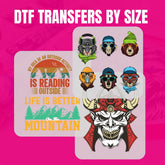DTF Transfers vs. Sublimation: Which One is Right for You?
If you're looking for the best way to print custom designs on apparel or other materials, you've probably come across two popular options: sublimation vs DTF (Direct-to-Film). Though they operate in distinct ways, both printing techniques create excellent designs. While DTF printing lays a layer of ink on top using a transfer sheet and adhesive powder, sublimation introduces ink into the substrate.
What you want to print, the kind of cloth you are dealing with, and the degree of durability you require will all affect whether DTF transfer sheets or sublimation are best. This article breaks out the main variations, clarifies the advantages of DTF transfers ready to press, and guides your choice of approach.
Understanding Sublimation Printing
Sublimation printing is a technique whereby heat turns ink into gas, embedding it into a polyester-based material. The end effect is a seamless, vivid design that won't peel or break with time. Printing on white or light-colored clothing is popular using sublimation because of its vivid and long-lasting colors.
How Sublimation Printing Works?
-
Sublimation ink allows the design to be printed onto unique sublimation paper.
-
The paper is heated with a heat press and laid on the fabric.
-
The ink produces a lasting print by turning it into gas and binding it with the cloth's fibers.
Strengths of Sublimation Printing
The durability and flawless finish of sublimation prints are well-known. The design stays soft to the touch even as the ink is incorporated into the cloth. This is perfect for sportswear, bespoke mugs, phone covers, and other polymer-coated goods.
There are certain restrictions, though. Only light-colored polyester-based fabrics will allow sublimation to work. Because the ink mixes into the fibers instead of sitting on top, it prints poorly on dark or cotton materials.
What is DTF Printing?
DTF (Direct-to-Film) printing is a more recent development that enables full-color, intricate drawings to be printed onto almost any fabric. DTF transfers ready to press can be applied on cotton, polyester, nylon, and mixes, which are far more flexible than sublimation, which requires polyester.
How DTF Printing Works
-
Special DTF ink is used in the design printing onto a DTF transfer sheet.
-
The printed design gets a fine coating of hot melt adhesive powder.
-
The print is next heat-cures and is ready for transfer.
-
The pattern is high-temperature and is applied to the fabric using DTF heat press settings.
As the transfer film is pulled off, the garment gains a strong, long-lasting print.
Why DTF Printing Stands Out?
DTF transfer sheets offer the greatest advantage in terms of adaptability. They will print on any cloth—cotton, polyester, silk, fleece, or even leather. Even on dark clothes, the colors stay vivid, rich, and detailed. Small companies that wish to print on several materials would find this approach ideal.
Still, another big benefit is the design's strength. Unlike sublimation, which embeds ink into cloth, DTF printing sits on top to produce a textured, somewhat raised impression that holds up well to washing and wear.
Comparing Sublimation vs DTF
Here are the key differences between DTF and sublimation
1. Fabric Compatibility
Limited applications for sublimation printing are polyester fabrics or polymer-coated hard surfaces. It won't hold on dark or 100% cotton materials. DTF transfers ready to press are your best option if you like to print on a black hoodie or a cotton t-shirt.
Conversely, DTF printing functions on any kind of fabric. DTF heat press settings let you apply flexibly across many materials, whether you work with cotton, polyester, fleece, or even denim.
2. Print Durability
Because the ink seeps into the cloth, sublimation is renowned for its longevity. Still, it might fade with time—especially if you wash often. The adhesive layer of DTF prints binds to the fabric, making them incredibly robust. Workwear, team uniforms, and extensively worn clothing would be perfect for them since they are resistant to cracking, peeling, or fading.
3. Color Vibrancy
Both techniques create brilliant, full-color designs. Sublimation does not use white ink, so designs may not show as vividly on colored materials. The white ink used in DTF printing lets light and dark fabrics show brilliant, sharp colors. DTF transfer sheets are, therefore, the perfect choice when working with strong, high-contrast graphics.
4. Feel of the Print
Since the ink fuses into the cloth, sublimation prints are entirely smooth to the touch. There is no raised design or texture. DTF prints lay atop the material to produce a somewhat elevated effect. While this increases durability, some individuals like the softer feel of sublimation.
5. Cost and Equipment Requirements
Sublimation printing requires a heat press, specific paper, and sublimation ink. Small companies and hobbyists would find it an excellent choice, as the startup expenses are minimal. Special DTF ink, transfer film, adhesive powder, and DTF printing require a DTF printer and a curing station. Although the initial cost is higher, companies would find it more wise long-term to be able to print on any fabric.
6. Production Speed
Sublimation is faster since it just requires printing and heats pressing. Adhesive powder or curing procedures are not necessary. Although DTF printing adds the step of applying and curing the adhesive powder, it lets you print in volume and save DTF transfers ready to press for next usage.
Which One Should You Choose?
Your demands will determine which sublimation or DTF is most appropriate. Sublimation is a great option if you mostly print on light-colored polyester cloths. Perfect for mugs, promotional goods, and sportswear is this. If you wish more freedom, DTF transfers ready to press are the best choice. Custom t-shirt companies, fashion firms, and workwear printers would find them ideal for printing on cotton, dark fabrics, and various materials. DTF printing is revolutionary for professional use. For companies with many orders, the capacity to save transfers and press them later also provides a time-efficient option.
Conclusion
Both sublimation and DTF printing have their advantages, but they serve different purposes. For polyester-based, light-colored products, sublimation is ideal; DTF transfer sheets let any cloth have full-color, durable printing. DTF printing is the most flexible and profitable option whether you like to print on a range of materials or are launching a small business.
It gives strong colors, increased durability, and the freedom to print on any fabric. When choosing between sublimation and DTF, consider your target products, budget, and long-term corporate objectives. For more information and to get started with DTF printing, visit DTF Transfer Art.
- bulk printing
- Custom clothing printing
- custom gangsheet
- decal transfer
- decal transfers
- Digital printing
- dtf transfer
- dtf transfer art
- dtf transfer film
- dtf transfer instructions
- dtf transfer paper
- dtf transfer printer
- dtf transfer sheets
- dtf transfers near me
- dtf transfers ready to press
- dtf transfers wholesale
- gangsheet printing
- heat transfer decals
- Printing companies
- Quality printing
- Transfer printing






